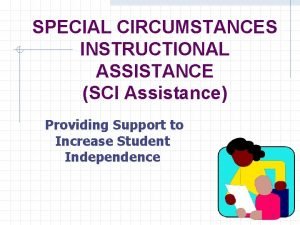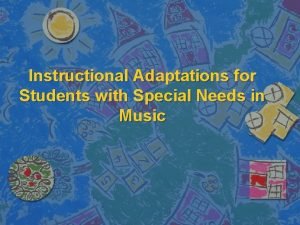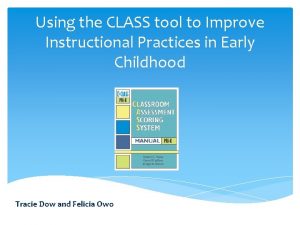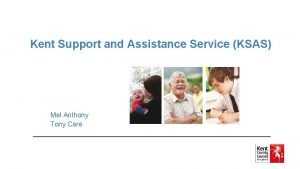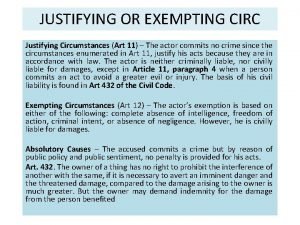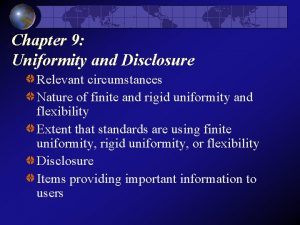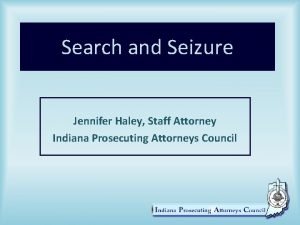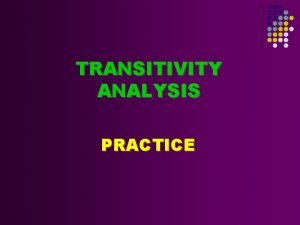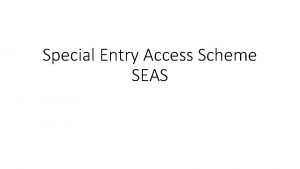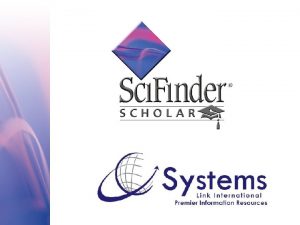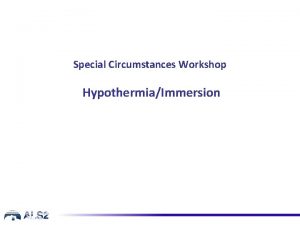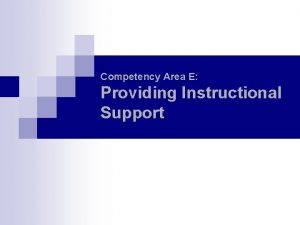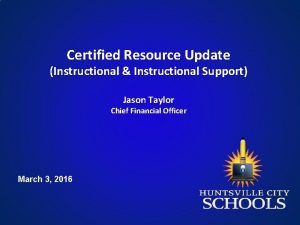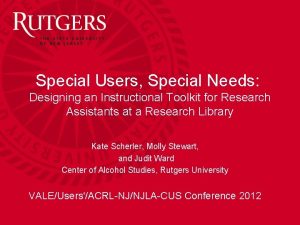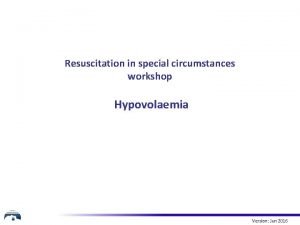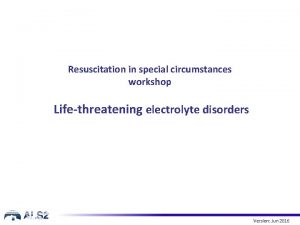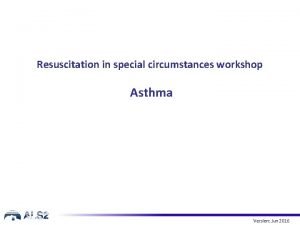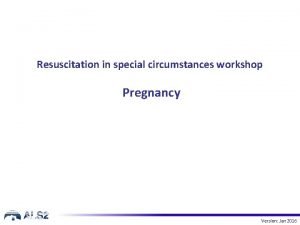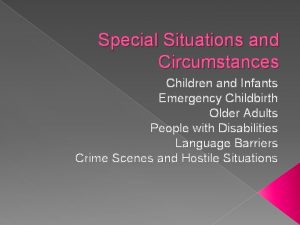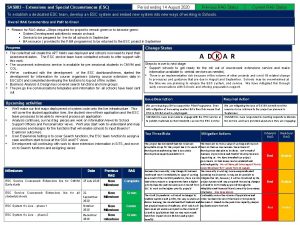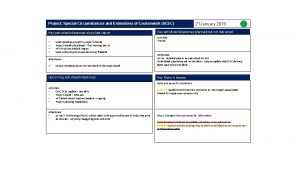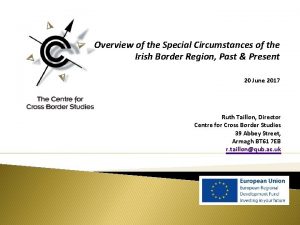SPECIAL CIRCUMSTANCES INSTRUCTIONAL ASSISTANCE SCI Assistance Providing Support
























- Slides: 24

SPECIAL CIRCUMSTANCES INSTRUCTIONAL ASSISTANCE (SCI Assistance) Providing Support to Increase Student Independence 1

IDEA 1997 amendments to IDEA allows “paraprofessionals and assistants who are appropriately trained and supervised, in accordance with State law, regulations, or written policy. . . to be used to assist in the provision of special education and related services to children with disabilities. ” 2

No Child Left Behind (NCLB) Students with Disabilities is a subgroup for school and district accountability n n 95% participation rate Percentage meeting proficiency Requirements for “Highly Qualified Teachers” (HQT) and paraprofessionals Students must have “opportunity to learn” the state standards 3

Successful Kids are Independent Take responsibility for own learning and actions Utilize natural supports for assistance Generalize skills in a variety of settings Develop positive peer interactions Develop skills to become life-long learners 4

Changing Role of Instructional Assistant School districts have employed paraprofessionals in classrooms for a number changes have necessitated an expansion of their role They now work along-side teachers to provide specialized services to special education students with unique needs 5

Advantages for 1: 1 aides Support in General Education Setting Behavior Interventions Medical Issues Instructional Assistance Mobility 6

Disadvantages of 1: 1 aides Lack of Independent Functioning Training May Not Be Adequate Hovering Assistants Teacher role becomes clouded May impeded Social Skills Development Codependent Communication Patterns 7

Current Process is Reactive The current practice of assigning 1: 1 aides without identification of actual needs Inappropriate reliance on 1: 1 assistance without plan to decrease support Instructional strategies, aligned with IEP goals, are not necessarily focused on increasing student independence Training for paraprofessionals and teachers has been inadequate 8

Proactively Fixing it. . Identify individual student need for possible SCI Assistance, such as n n n Academic progress is very limited Behavior challenges have not responded to other interventions Student is disruptive to the educational progress of other students Less intensive interventions have not met the student’s needs Other 9

Additional Factors n n n n n Lack of training (teacher or assistant) Overcrowded classes Inappropriate student placement IAs doing paperwork or bulletin boards Limited classroom modifications or accommodations Ineffective substitute assistants Poor utilization of natural supports being used Lack of assistive devices Difficulty with implementation of behavioral interventions 10

Evaluate the Student’s Specific Need for Assistance The SCI Assistance Evaluation Process 11

34 C. F. R. Sec. 300. 532 (b) A variety of assessment tools and strategies are used to gather relevant functional and developmental information about the child, including information provided by the parent, and information related to enabling the child to be involved in and progress in the general curriculum…that may assist in determining… (2) The content of the child’s IEP 12

Step 1 - Identify Specific Concerns with Supporting Documentation Referral (Step 1 - Form 1), including results of previous interventions and other unique needs the student n Student Rubric (Step 1 - Form 2) n n n of Review of Behavior Support Plan or Behavior Intervention Plan (Step 1 - Form 3) Review progress on IEP Goals Gather other data and records as appropriate 13

Step 2 – Complete the Evaluation Plan and Obtain Parent Permission Utilize standard Evaluation Plan process Include Notice of Proposed action Evaluation to include: n n n Interviews Observations Assessments Obtain parent consent 14

Step 3 – Conduct Interviews Parent/Legal Guardian (Step 3 - Form 1) Teacher(s) (Step 3 - Form 2) Student if appropriate (Step 3 - Form 3) 15

Step 4 - Conduct Observational Evaluation and Additional Assessments Multidisciplinary Team approach Complete all components within timelines Review strategies, materials, modifications, and/or accommodations currently in place Complete Observation Evaluation (Step 4 Form 1 a-d) Complete additional assessments 16

Step 5 – Develop Evaluation Report Summarize results Develop SCI Assistance Evaluation Report (Step 5, Form 1 a-b) Schedule IEP meeting 17

Step 6 – Hold IEP meeting Review results of SCI Assistance evaluation and recommendations If SCI Assistance is recommended, specific goals and objectives, monitoring strategies, and fading strategies are written on IEP Set review date for next IEP to assess continued need of SCI Assistance (recommended within 6 months but no later than next annual IEP review) If SCI Assistance is not recommended, specify natural supports, accommodations, and/or modifications that are effective in student’s program; add IEP goals if appropriate 18

Step 7 – Request/Assign and Train Staff to Provide SCI Assistance Submit appropriate paperwork in accordance with district procedures Not the role of IEP team to decide specific staff member for assignment Schedule training and support for IEP implementation 19

Teacher Training Regardless of outcome of SCI Assistance evaluation, training also needs to be provided to General and Special Education teachers and site administrators n n Inclusive practices Modification of curriculum Proactive behavioral strategies Working with instructional assistants 20

Paraeducator Training Role in the classroom Positive communication strategies and team skills Characteristics and needs of individual student(s) Strategies to promote independent functioning Proactive behavioral strategies Curriculum modification Data reporting Health and safety procedures Confidentiality and mandated reporting 21

Step 8 – Complete Observational Review to assess the effectiveness of SCI Assistance and to monitor duration of services Complete Observational Review to Determine Continued Need for SCI Assistance (Step 8 Form 1 a-b) If SCI Assistance is continued, IEP team identifies next scheduled observation date (recommended within 6 months but no later than next annual IEP review) 22

Communication Patterns The classroom teacher is the hub of all communication The parent communicates with the teacher, not the paraprofessional The teacher and the assistant must have time to meet and plan peers--provide natural supports Plan for student social interaction with The entire team meets periodically to evaluate and review 23

SUCCESS will occur… when the student can function at maximum INDEPENDENCE 24
 Special circumstances instructional assistance assessment
Special circumstances instructional assistance assessment Examples of special circumstances letter
Examples of special circumstances letter Providing support services facilities and other amenities
Providing support services facilities and other amenities Instructional adaptations for special needs students
Instructional adaptations for special needs students Class domains and dimensions
Class domains and dimensions Ksas apply online
Ksas apply online Special support unit
Special support unit Signal words
Signal words Concatenation of circumstances
Concatenation of circumstances Temporal circumstance
Temporal circumstance What three circumstances hurt native american
What three circumstances hurt native american Face bnok
Face bnok Justifying and exempting circumstances
Justifying and exempting circumstances Trusting god in all circumstances
Trusting god in all circumstances Deakin engagement and access program
Deakin engagement and access program Jeopardy romeo and juliet
Jeopardy romeo and juliet Change in circumstances
Change in circumstances Relevant circumstances adalah
Relevant circumstances adalah Totality of the circumstances
Totality of the circumstances Exigent circumstances
Exigent circumstances Life is never made
Life is never made Participants processes and circumstances
Participants processes and circumstances Special entry access scheme monash
Special entry access scheme monash The circumstances or conditions that surround one
The circumstances or conditions that surround one Cas sci
Cas sci
